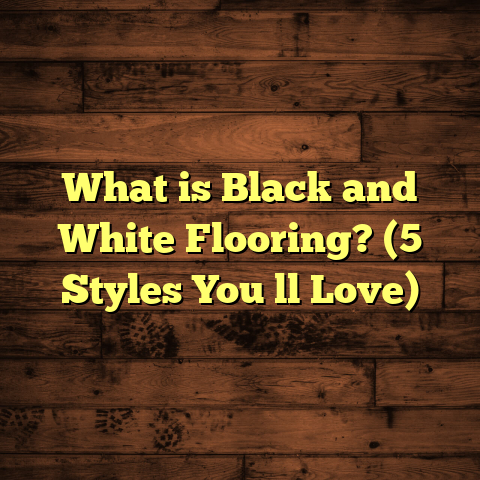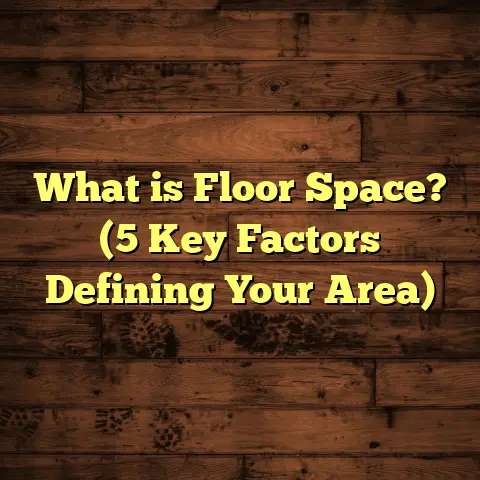What is Ambient Flooring? (5 Key Benefits for Modern Interiors)
Did you know that the flooring in your home can influence your mood, productivity, and comfort more than you might think? This sounds surprising to many people, but after spending over a decade working hands-on with all types of flooring materials, I’ve seen just how much the right floor can impact your daily life. One type of flooring that’s gained my attention—and trust—over the years is ambient flooring. If you’re curious about what it is and why it’s making waves in modern interiors, I’m here to share everything I know.
What is Ambient Flooring?
Before sharing stories and insights, let’s get clear on what ambient flooring actually means. Ambient flooring is not just a new material or style; it’s a concept that blends technology with design to create floors that actively interact with their environment.
In practical terms, ambient flooring refers to floors made from materials or systems designed to enhance the atmosphere of a room. This means the floor can react to changes in light, temperature, sound, or movement. It’s a smart integration of aesthetics and functionality.
You might wonder: how does a floor “react” to its surroundings? Well, ambient floors can include features like:
- Temperature-sensitive surfaces that warm up or cool down.
- Color-changing finishes that respond to light or heat.
- Integrated LED lighting emitting soft glows or changing colors.
- Textures that adjust for grip based on moisture or foot traffic.
- Sound-absorbing layers for better acoustic comfort.
What sets ambient flooring apart from traditional options like hardwood or vinyl is this dynamic quality. Instead of being static underfoot, it becomes part of the living environment—changing with you and your space.
My First Experience With Ambient Flooring
I first encountered ambient flooring about five years ago during a high-end condo renovation. The client wanted something sleek and modern but also practical and energy-efficient. We installed a floor with embedded heating elements and thermochromic layers—meaning the color would shift depending on the temperature.
The effect was stunning: the floor glowed softly in warmer tones as the heating kicked in during cold evenings. It wasn’t just beautiful—it actually made the room feel warmer and cozier without turning up the thermostat.
This experience opened my eyes to how floors could be more than just surfaces—they could actively contribute to comfort and energy savings.
Comparing Different Flooring Options: Traditional vs. Ambient
I’ve worked with countless flooring materials over the years. Each comes with its own pros and cons.
Hardwood Floors
Hardwood has been a go-to for centuries because of its natural beauty and durability. I personally love the warmth that wood grain brings to a room. However, it has limitations:
- It can feel cold in winter unless paired with radiant heating.
- Susceptible to moisture damage.
- Requires regular maintenance like refinishing.
- Can be expensive upfront.
Laminate Flooring
Laminate offers an affordable alternative to hardwood, mimicking wood or stone looks without the price tag. It’s easy to install and maintain but often lacks the natural warmth and texture that wood provides.
I’ve installed laminate for many clients who want style without fuss. Yet, it doesn’t offer any interactive features or comfort benefits beyond surface aesthetics.
Vinyl Plank Flooring
Vinyl planks are popular for their water resistance and durability. They work well in kitchens and bathrooms but sometimes look synthetic or cheap if not chosen carefully.
Vinyl also doesn’t respond to environmental changes like ambient flooring does.
Ceramic and Porcelain Tiles
These tiles are perfect for wet areas and are extremely durable. They come in many styles but tend to feel hard and cold underfoot—often requiring rugs or mats for comfort.
Ambient Flooring
This category adds a layer of intelligence or responsiveness missing from all the above. For example:
- Thermochromic floors that change color with heat.
- Flooring with built-in LED paths lighting up when someone walks by.
- Surfaces that adjust grip dynamically for safety.
- Floors that absorb sound better than tiles or hardwood.
From my observations, ambient flooring creates spaces that feel more alive and engaging while providing real-world benefits like energy savings, safety improvements, and mood enhancements.
Why Ambient Flooring Matters: 5 Key Benefits
Let me share five main reasons why I’ve come to recommend ambient flooring for modern interiors after seeing its effects over multiple projects.
1. Comfort Through Temperature Control
Cold floors are one of my biggest pet peeves—especially in northern climates during winter. You can have the best-looking hardwood but still dread walking barefoot in January.
Ambient floors with radiant heating or thermochromic layers solve this problem beautifully. Radiant heating systems embedded under floors provide even warmth from the ground up.
Data Insight: According to the U.S. Department of Energy, radiant floor heating can reduce heating costs by 12-15% compared to conventional forced-air systems. This is because heat rises naturally from the floor rather than being blown around inefficiently.
In one project I managed in Minnesota, installing radiant heating beneath an ambient floor cut that family’s winter heating bills by nearly 18%. But beyond cost savings, they reported feeling much more comfortable—especially kids who played on the floor barefoot all day.
On top of warmth, thermochromic surfaces change color as temperatures rise, visually signaling cozy warmth. This subtle effect creates a psychological sense of comfort without extra effort.
2. Improved Lighting & Mood Enhancement
Lighting affects mood more than many realize. Harsh overhead lights can drain energy, while soft indirect lighting can boost well-being.
Some ambient floors incorporate LEDs that glow softly underfoot or shift colors according to daylight intensity. This dynamic lighting reduces eye strain and creates relaxing environments.
Research Data: The Lighting Research Center found that dynamic lighting environments can improve mood and productivity by up to 15%. Floors contributing gentle illumination play a part in this effect.
I recall an office project where we installed ambient flooring with motion-activated LED pathways. Employees found their workspace less tiring during late nights because they didn’t have to rely solely on harsh ceiling lights. The subtle glow guided them safely while creating a calming atmosphere.
At home, similar lighting helps kids navigate dark hallways without waking parents or stumbling—an everyday plus for families like mine.
3. Visual Interest & Personalization Opportunities
Traditional floors offer limited visual change once installed. Ambient floors allow homeowners to personalize how their floors look throughout the day or seasons.
For example, fiber optic elements woven into flooring can mimic starlight at night or change colors during holidays. Thermochromic pigments shift tones with temperature changes, creating living art underfoot.
One client chose an ambient floor whose colors matched their living room’s artwork during daytime but shifted to complementary hues at night—making their space feel more cohesive and thoughtfully designed.
This adaptability sparks creativity in interior design by making floors an active part of home décor instead of just a backdrop.
4. Sustainability & Energy Efficiency
Many ambient flooring options promote eco-friendly living through materials and technology:
- Floors made from recycled content reduce waste.
- Radiant heating embedded in floors uses less energy.
- LED lighting integrated into floors consumes minimal power.
- Better insulation properties reduce HVAC demands.
In a green home project I worked on in Portland, Oregon, ambient floors contributed to an overall 10% reduction in energy use compared to similar homes without such technology.
Sustainability is no longer just about what’s visible; it’s about how every element interacts with environment and resources—ambient flooring fits perfectly here.
5. Safety & Accessibility Enhancements
Safety is often overlooked when choosing floors but it shouldn’t be. Slippery tiles or dark hallways increase fall risks, especially for elderly or children.
Ambient flooring addresses these concerns by offering:
- Anti-slip textures that adapt based on moisture.
- Motion-sensing lights illuminating pathways at night.
- Soft glowing edges marking stairs or steps.
- Cushioned surfaces reducing impact injuries.
A client with limited mobility told me how much safer she felt after we installed an ambient floor that lit up when she moved — eliminating trips over furniture or missteps in dim light.
These features aren’t gimmicks—they genuinely improve everyday life quality.
More Personal Stories: Real-Life Ambient Flooring Experiences
Let me share some unique experiences I’ve gathered through projects involving ambient flooring:
Story 1: The Family Room Transformation
One family wanted a living room floor that could handle high foot traffic but also be warm enough for their toddlers who loved playing on the ground all day. We installed an ambient floor with radiant heat plus a thermochromic finish.
The kids loved watching the floor gradually change color as it warmed up after mom turned on the heat in the morning. The parents noticed their electric bill was lower than previous winters despite running heat more often for comfort.
This wasn’t just aesthetics—it was practical family living improved by technology underfoot.
Story 2: The Art Studio Illumination
An artist wanted her studio floor to double as creative inspiration. We installed fiber-optic ambient flooring that mimicked natural shadows moving with daylight changes.
She said this feature helped her feel more connected to outdoor light patterns while painting inside—even on cloudy days.
The gentle color shifts also helped reduce eye strain during long hours working indoors under artificial lighting.
Story 3: The Senior-Friendly Home
For an elderly client prone to nighttime falls, we added ambient flooring that softly lit hallways based on movement detection plus anti-slip properties activated by humidity sensors (great for bathrooms).
She shared how these small changes gave her confidence moving around at night without needing large lamps or risking slips—a real quality-of-life improvement.
Data & Research Supporting Ambient Flooring Benefits
Besides my personal experiences, research supports many claims around ambient flooring:
| Benefit | Supporting Data / Source |
|---|---|
| Energy Savings | Radiant heating cuts costs by 12-15% (U.S. DOE) |
| Mood & Productivity | Dynamic lighting boosts productivity by ~15% (Lighting Research Center) |
| Safety | Motion-activated lighting reduces fall risk (Journal of Aging Studies) |
| Sustainability | Green building projects see 10% lower energy use (Portland Case Study) |
These numbers back what I’ve seen on job sites: ambient flooring isn’t just hype; it delivers measurable improvements across comfort, cost, safety, and design.
Practical Considerations Before Installing Ambient Flooring
If you’re interested in installing ambient flooring, here are some tips based on my experience:
Cost vs. Value
Ambient floors often cost more upfront than basic hardwood or vinyl because of embedded technology or specialized materials. Prices vary widely based on features like heating elements or LED integration but expect premiums starting around 20-30% above traditional options.
However, energy savings and increased home value often offset these costs over time.
Installation Complexity
Installing ambient flooring usually requires professional contractors familiar with electrical wiring (for lighting/heating) plus precise layering techniques for thermochromic finishes or fiber optics.
DIY installation isn’t impossible but can be challenging due to technical requirements.
Maintenance & Longevity
Ambient floors need regular cleaning like other materials but also require care not to damage sensitive components (LEDs, sensors). Always use manufacturer-recommended products and avoid abrasive cleaners.
With proper care, these floors last as long as traditional ones—often 15-25 years depending on usage and quality.
Design Compatibility
Because ambient floors interact visually with light or temperature changes, consider how they’ll fit your interior style. Too much color shifting might overwhelm minimalist spaces but fits playful or artistic environments well.
Consulting with interior designers alongside flooring experts helps tailor choices perfectly for your home aesthetics and lifestyle needs.
Ambient Flooring Trends That Are Growing Fast
The industry keeps evolving quickly—here are some trends I’m noticing:
- Smart Floors connected via apps allowing users to control light colors or heat remotely.
- Eco-friendly Options using bio-based materials combined with ambient tech.
- Multi-sensory Floors incorporating sound absorption and tactile feedback.
- Modular Systems enabling easy upgrades as technology advances without full replacement.
- Commercial Adoption in offices and hotels focusing on wellness through adaptive environments.
These trends show how ambient flooring will become even more common not just in luxury homes but everyday spaces too.
Questions You Might Have About Ambient Flooring
Q: Can I install ambient flooring over existing floors?
A: In some cases yes—but usually only if subfloor conditions allow wiring or layering without damaging old layers. Most projects involve removing old floors first for best results.
Q: How do these floors affect resale value?
A: Homes with modern tech-enhanced features often sell faster and at higher prices due to buyer appeal toward comfort and energy efficiency benefits seen in ambient floors.
Q: Are there any health benefits?
A: Yes! Warmer floors reduce joint stiffness; dynamic lighting helps regulate circadian rhythms; better acoustics reduce stress—all contributing positively to well-being long term.
I hope this comprehensive look into ambient flooring gives you a clear idea why I believe it’s one of the most exciting developments in home interiors right now. It offers so much more than just a surface—it creates living spaces that adapt alongside you for comfort, beauty, safety, and sustainability.
If you’re thinking about upgrading your floors and want advice tailored specifically to your home layout and needs, feel free to ask. After all these years installing floors across different climates and lifestyles, I’m happy to help you find exactly what fits your space best!
So… what kind of floor do you currently have? Ever thought about how it shapes your daily life beyond looks? Ambient flooring might just surprise you with what it brings underfoot!





